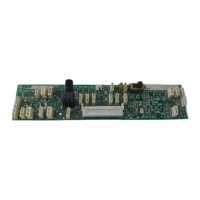8
AMPLUS™ 100 THEORY OF OPERATION
Sheet 1 of 3 (continued)
Note that the U104/105 output is also taken directly, before the EQ card, to two of the
volume control VCAs (U204A, D), for use as Line Outputs. U204B, C implement the
volume control for the main CH1 and CH2 paths that will move forward in the AmPlus 100
itself.
U204 [C2] is a quad, current in /current out, voltage controlled amplifier. Sections U204A,
D, pins 4 and 13, (line output) are controlled only by the remote volume control action,
whereas sections U204B, C, pins 5 and 12, (main path) are also controlled, in an OR'd
fashion, by the signals CLIP / SC1 [D1] and CLIP / SC2 [A1]. The CLIP / SC signals
become active when the power amplifier is clipping and/or attempting to drive a short
circuit. This reduces the volume control setting, preventing distortion when a user plays
the system too loud, as well as reducing power dissipation when there is a short circuited
load.
Connector J4 [A8] ties one or two 10K rheostat-connected remote volume control
potentiometers into Q201/221, whose outputs are steered by S5 [B4] (1 Remote / 2
Remotes) into U200 A, B, C, D, [B, C3] which inverts and scales the voltages to the
appropriate range needed to control the VCAs. U203A, B [B4] buffer the CLIP / SC
signals and OR them into the appropriate sections of U204 via diodes D200, 203. J12
[A8] is reserved for a possible future level control option.
U201A, U202B [B / C1] are the line output buffers, whose outputs are passed through
series R/shunt C elements for RFI management. At the junction of the resistors, FETs
Q401, 403 [A, B6] provide a power-up/power-down mute so that equipment connected to
the line outputs will not experience thumps or pops.
Sheet 2 of 3
Refer to the AmPlus 100 schematic diagram, sheet 2 of 3 for the following information.
Sheet 2 concludes the processing of the Ch 1 and Ch 2 signals, preparing them for the
power amplifiers. Circuits on this sheet deal largely with dynamic EQ and switchable EQ,
all directed toward the bass region. The CH1 signal (DYNEQ1) entering Sheet 2 [C8] is
sent in parallel to five points. Two paths pass through S4 [D6], which selects HP Out
(150Hz high pass filter off) or HP In (150Hz high pass filter in). Another path, through R4
[D8], Ch 1 Bass Boost Adjust (50-150Hz) and a bandpass filter, U300B [D5], determines
how much bass boost will be present. The signals out of S4 and the bandpass filter are
summed in U300A [C4], along with yet another equalized signal.
To develop Dynamic EQ (an equalization where the amount of bass boost applied
varies inversely with the signal level), the DYNEQ1 signal [C8] is fed to circuits
composed of U300D, Q300, Q301, Q302, U303, U300C, U302A, and U304. U300C,
Q300, Q301, Q302 develop a current proportional to the rectified signal level. This current
enters the control pin of U302A, a transconductance amplifier, whose output current is
multiplied by its control current. U302A is in the negative feedback loop of U300D, which
now passes the signal DYNEQ1 with a gain controlled inversely by its own level. At
small signals, the gain is the highest. Next, the output of U300D passes through one of
two bandpass filters, shaping the signal into a bass boost signal. U304 [C4] selects
between two bandpass filters, one centered at 55Hz and appropriate for the Free Space
®
Model 1B Acoustimass
®
Module, the other at 90Hz, appropriate for full range systems,
such as the Model 8, Model 25 and Model 32 Loudspeakers.
Switching to the 55Hz bandpass filter is automatically handled by sensing when a
Model 1B EQ card has been inserted in the Ch 1 EQ card socket [J9 on sheet 1 at
coordinates D5] (signal EQGND [D1, sheet 1, and B8, sheet 2] is shorted to ground by
the Model 1B EQ card when it is plugged in).

